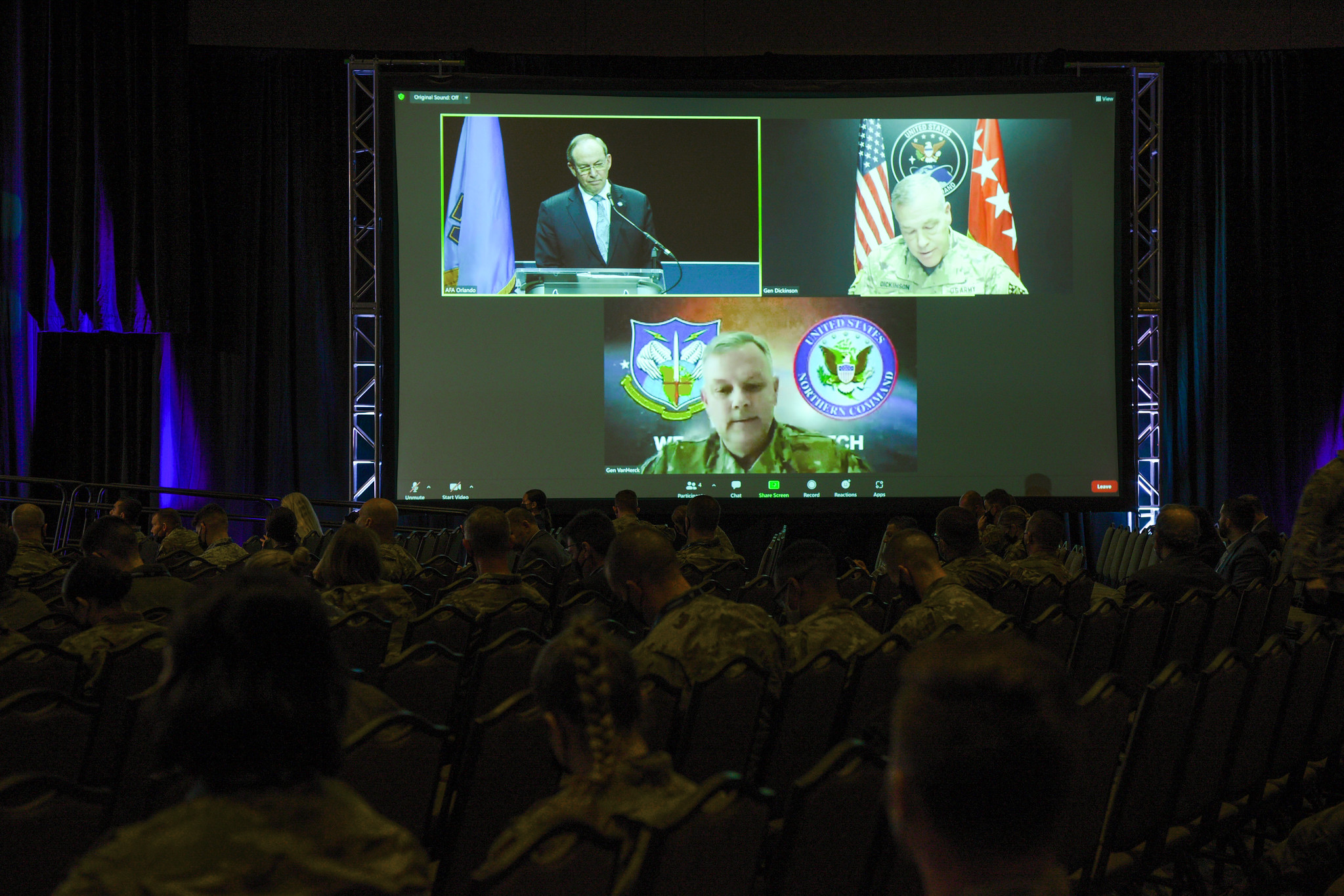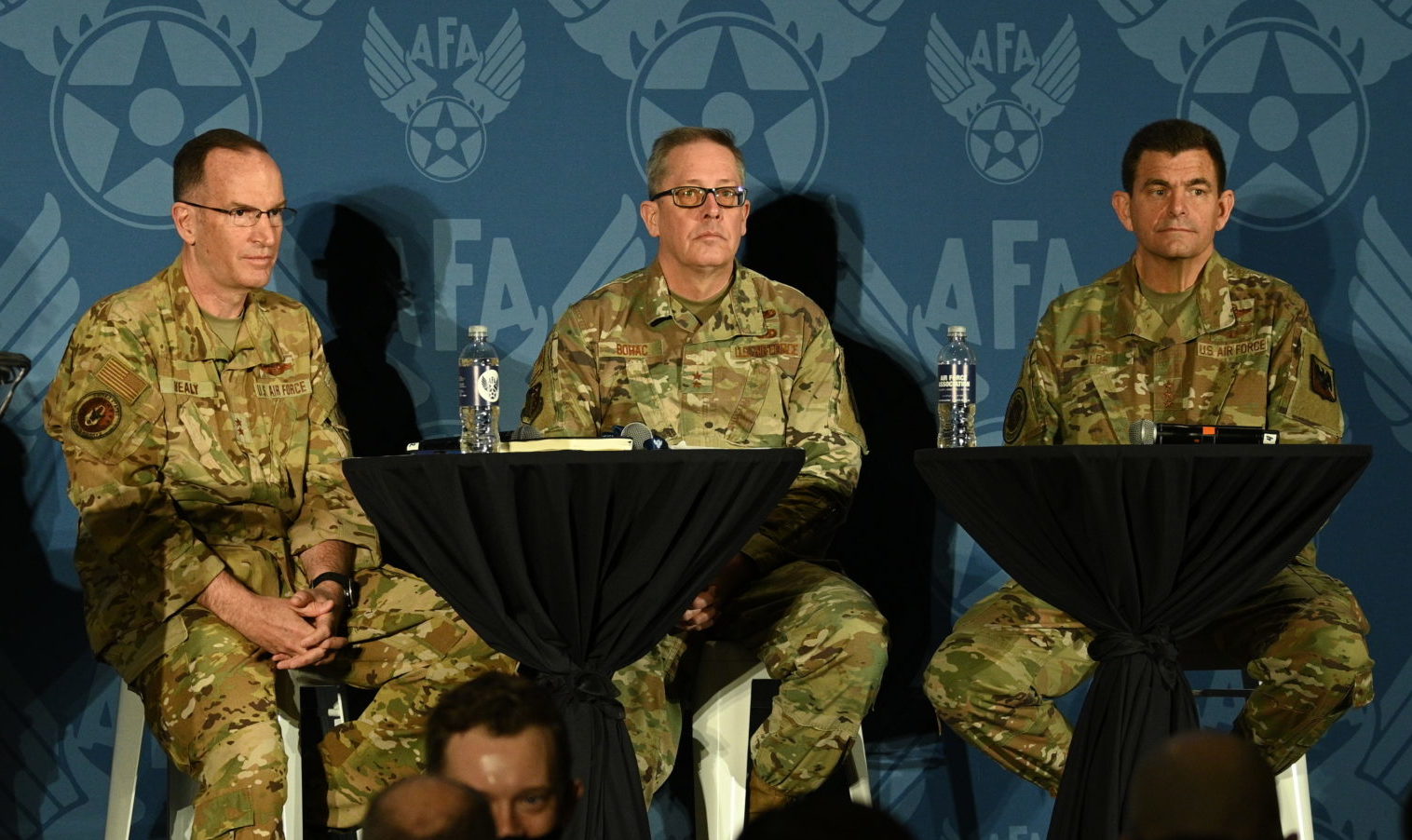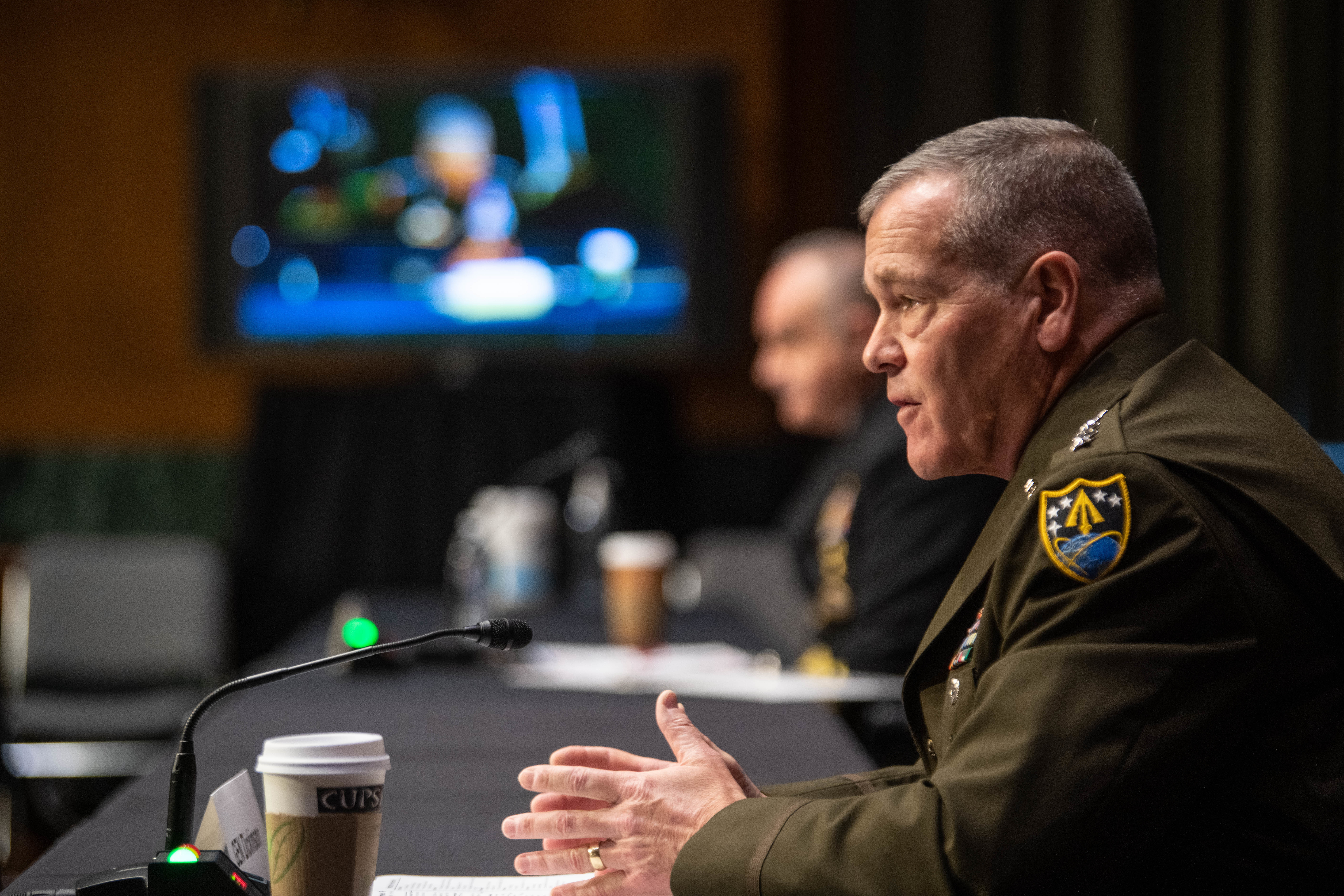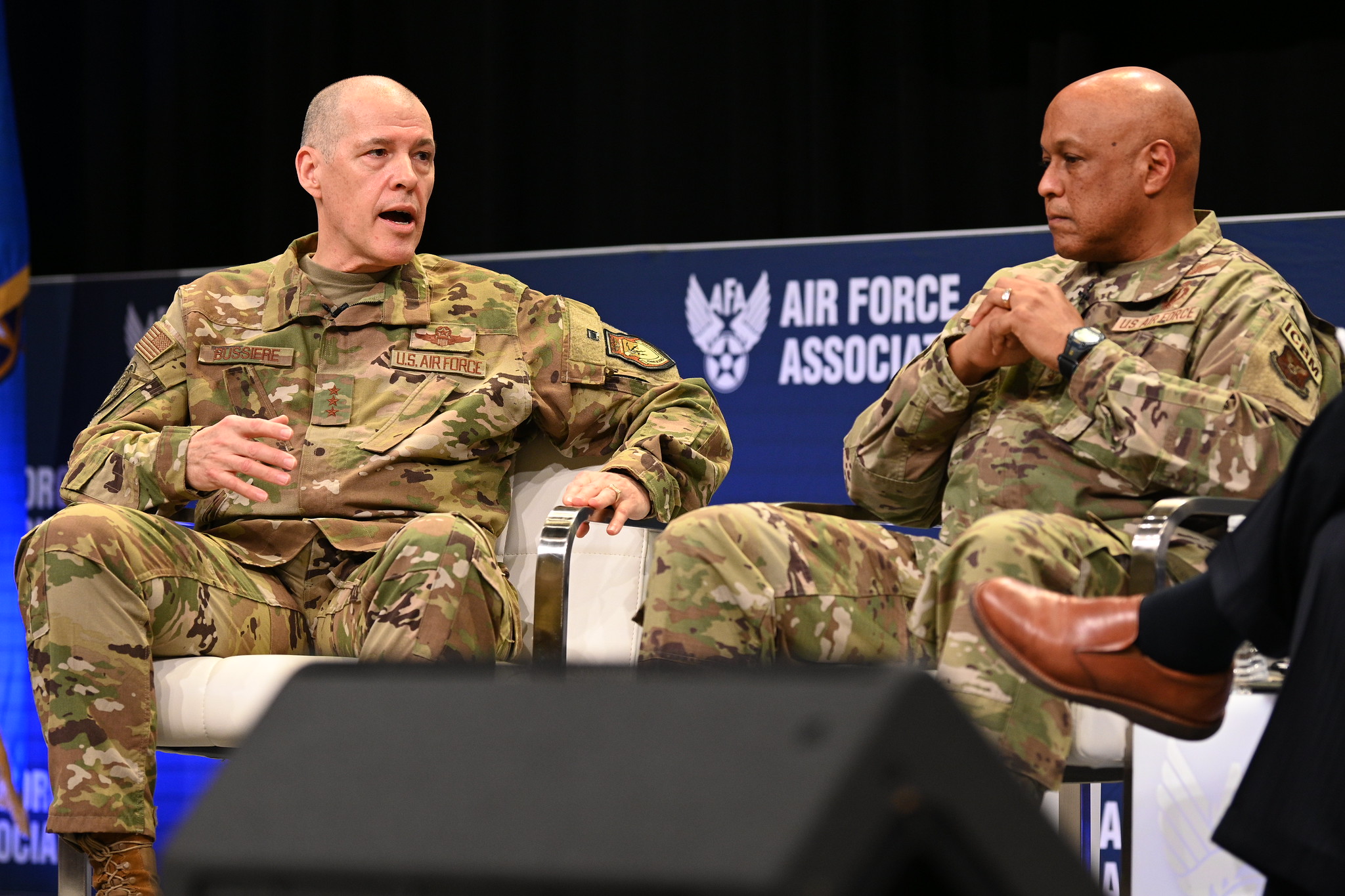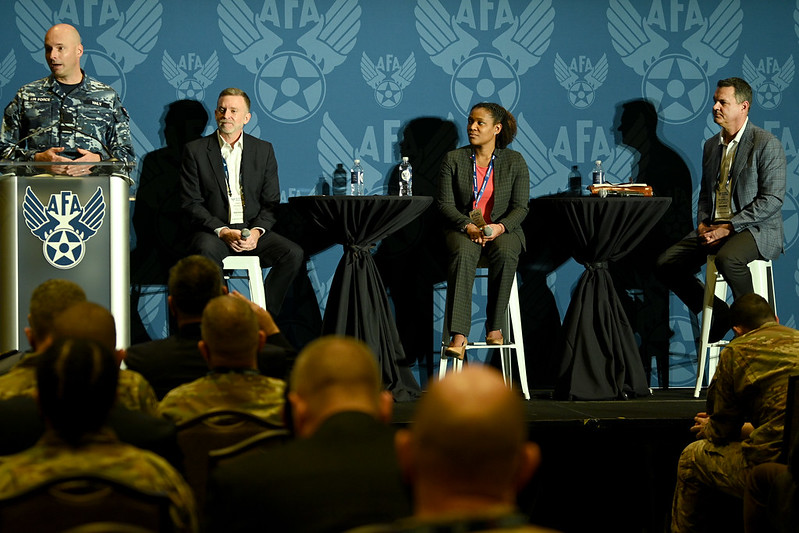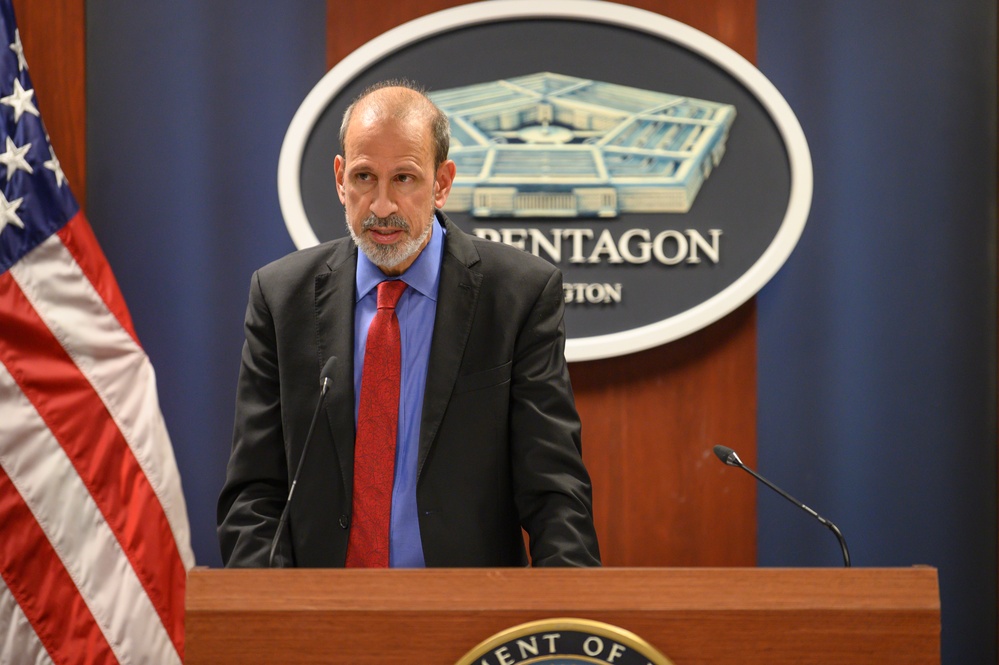Retired Lt. Gen. David A. Deptula, dean of the Air Force Association’s Mitchell Institute for Aerospace Studies, moderates a panel discussion called, “The Threats Come Home,” with Army Gen. James H. Dickinson, commander of U.S. Space Command, and USAF Gen. Glen D. VanHerck, commander of U.S. Northern Command and North American Aerospace Defense Command, during the AFA Warfare Symposium on March 3, 2022. Watch the video or read the transcript below. This transcript is made possible through the sponsorship of JobsOhio.
Overhead Voice
Ladies and gentlemen, please welcome back to the stage, the dean of AFA’s Mitchell Institute of Aerospace Studies, Lieutenant General David Deptula.
Lt. Gen. David Deptula, U.S. Air Force Retired
Hey everybody, if you would please grab your seat and we’ll get started for this next session. Welcome to you all, I think you will find this session particularly interesting as the scale and scope of the challenges facing our nation today are immense. I really don’t have to go into a whole lot of detail on that because anyone reading the news knows that threats hold our homeland at risk today. Peer competitors are building new long-range missiles, cyber weapons, and other means of attack that pose severe challenges to our defenses. Looking abroad, the aggressive moves by not just Russia, but China also to seize territory and destabilize our allies and partners continue to menace our collective security. Now, just like space, we used to think of our homeland as a sanctuary. Well, that’s no longer the case. It’s crucial that we look to leverage a combination of existing and emerging technologies, allied partnerships, and forward-looking operational concepts to keep our nation safe.
So with that as context, let me introduce our two panelists for this session, who will be joining us virtually — it truly is the information age. As the commander of US Northern Command and North American Aerospace Defense Command, General Glen VanHerck leads the organizations with primary responsibilities for homeland defense and aerospace warning. Prior to assuming this role, General VanHerck served in multiple leadership positions, including most recently as director of the Joint Staff at the Pentagon. General James Dickinson is the commander of US Space Command, the 11th and most recently established unified combatant command. General Dickinson has had a lengthy career in army artillery and air defense, and has previously served as the commanding general of the Army’s Space and Missile Defense Command. So welcome, gentlemen. It’s really a pleasure to have you join us today, even though it is electronically. And what I’d like to do is start off by giving General VanHerck the floor, followed by General Dickinson, for some opening thoughts on defending our homeland in an era of renewed great power competition. So General VanHerck, you’ve got the stick.
Gen. Glen VanHerck
Thanks, General Deptula. And give me a thumbs-up. Can you hear me OK?
Lt. Gen. David Deptula, U.S. Air Force Retired
Can you hear him in the audience? I think we need to raise the volume. If you can hear us in the back, raise the volume.
Gen. Glen VanHerck
I’ll keep talking. Can you hear me better now?
Lt. Gen. David Deptula, U.S. Air Force Retired
Yeah, we’ve got you good now.
Gen. Glen VanHerck
OK. Thanks, General Deptula. Let me thank the Air Force Association in general, General Wright and yourself, for all your support to all our Airmen, Guard, excuse me, Guardians around the world. I apologize I’m not there with you in person. Business got in the way, let’s just say that, and I had to stay here in DC for some meetings today. But the theme of what you’re talking about today, threats come home, couldn’t be any more timely, candidly. You know, it’s something that we’ve been talking about it NORAD and NORTHCOM for at least the 18 months, I’ve been commanding, and the predecessors as well. And both China and Russia have done us a lot of favors. And unfortunately, they’ve done some favors, starting with their January, or rather July Fractional Orbital Bombardment, delivery of the HGV. And now with what Russia is doing, it’s got everybody’s attention, especially for the threats of the homeland. And so that’s helping move that ball down the field. So what’s really different today, when you look at the strategic environment? Well, the competitors, the strategic competitors we face today, have watched our way of projecting power for at least two decades, if not longer than that. And they understand if we’re allowed to project that force forward, that won’t turn out well. So they’ve developed capabilities below the nuclear threshold, to hold us at risk with the idea that they can delay. disrupt our force flow or destroy our will, so that we don’t project power into a regional crisis or a regional conflict.
And my concern with that, is they’re eroding our decision space and our deterrence options from the homeland especially. And it’s decreasing our senior leaders’ decision space. And what I worry about that is, the risk of strategic deterrence failure goes up dramatically. I’ll be happy to talk specifics on that. I’m not going to go into threat, I think everybody understands it. What I would just say is the threat today demands that we think differently about how we’re going to defend the homeland. And you don’t have to put a Patriot or THAAD on every corner and have batteries all over the place. It’s figuring out what we must defend that could bring us to our knees in a crisis or conflict. And that’s not my decision. That’s a policy decision that we’ve been working on for a while to get. And that’s a broad decision across the interagency, in my mind. It requires some significant analysis and linking of, what are those key critical infrastructure areas that we need to focus on? And why do we need to focus on it. Is it to protect our finance capability? Is it to protect energy and economics? Is it to protect foreign power projection? And we’re working through that now. And there’s obviously a sense of urgency to figure that out. But what it forced us to do at NORTHCOM and after I got into command was come up with a couple of different strategies, if you will. We had two strategies, actually a NORAD strategy and a NORTHCOM strategy, and General Deptula, I merged those to a single strategy, because the commands are absolutely inseparable. I, and now we, have a single strategy. And that strategy actually focuses on integrated deterrence. And so my strategy was doing integrated deterrence. And I think you’ll see the National Defense Strategy as well, we’ll focus heavily on integrated deterrence and campaigning. And that’s where we need to be. So we do need to figure out what we must defend. But also, we need to focus on that strategy that demonstrates integrated deterrence. And what is that?
Well, I don’t think there’s a common lexicon or understanding of what integrated deterrence really is. So I’ll just tell you what I think it is. It’s the influence of every lever that we have, not only here in the department, but across the entire interagency. It’s with our fellow combat commanders, it’s with our fellow allies and partners, and that in every operation activity, investment and exercise, whether that be under COCOM authority, whether that be in service authority, has a deterrent value when messaged properly. Services have deterrent value as they build readiness when messaged properly and we demonstrate readiness and capability. And so I think our allies and partners are absolutely asymmetric advantages as well, as we do theater security cooperation with allies and partners just as much. Now the Western Hemisphere is crucial, it hasn’t gotten a lot of attention. But I will tell you that China and Russia are actively seeking supporters in the Western Hemisphere and campaigning. And those operations, activities and investments are crucial to us in the Western Hemisphere. So I believe, to be able to execute the National Defense Strategy, and to campaign like I’m talking about, requires us to get further left and think more about creating options in decision space, rather than reacting to threats in the homeland. We need to be able to react sooner and forward and generate a doubt in their mind about ever being successful in striking into our homeland. And that requires domain awareness. My top priority is domain awareness. It’s about having data and information from undersea to on orbit and everything in the middle and taking that data, analyzing it sooner than we do today. It’s using machines, it’s using artificial intelligence to give options to our key senior leaders in a timely manner, so that they can focus on deterrence and de-escalation if required and defeat if required.
I rely on Jim Dickinson significantly for domain awareness. SPACECOM is crucial, as is US Space Force and the United States Air Force. My missions, especially threat warning and attack assessment, Jim Dickinson provides that for me. My missile defense capabilities, SPACECOM provides much of that for me. So we’re tied together very closely to make sure that we get after the problems that I’m talking about. My ultimate goal is to focus on getting further left and campaigning and leveraging every opportunity that we can. What I would also tell you is the basics that I do, such as hurricane response, wildfire response, even COVID pandemic, every one of those, when you demonstrate readiness, resiliency, capability, responsiveness, when messaged correctly, has a deterrence value. And we need to think more about those things. The ability to react in this nation and respond is amazing. And so I’m looking forward to continuing to work with the services etc. to get more of that going. And if deterrence fails, I just tell you, my homeland defense design starts with my fellow combatant commanders forward and allies and partners, I need to generate effects forward in their AORs before they become a threat here in the homeland. And so I’m going to rely on General Wolters, I’m going to rely on Admiral Aquilino, to ensure those threats don’t actually come to the homeland. But if they do, we’ll figure out what must be defended. And so this requires culture shift. It requires everything we think about from a planning aspect to be globally integrated. There is no regional fight. They’re all global in nature. They’re all-domain in nature. It also requires us to think about homeland defense and the risk of strategic deterrence failure before we ever enter into any ladder of escalation. We’re on a ladder of escalation right now, General Deptula, and the discussion for potential escalation and de-escalation is a crucial part of where we are right now. And so I’ll pause there, and let General Dickinson go, and I look forward to any questions.
Lt. Gen. David Deptula, U.S. Air Force Retired
Thanks very much. Over to you, General Dickinson.
General Jim Dickinson
Hey, good afternoon. Great to see General Deptula, and thank you for that always kind introduction and moderating the panel today. And I would be remiss if I didn’t give a shout out to Lieutenant General Wright for the invitation as well. And I think maybe today, somebody told me in my J-2 that it might be his birthday today. So happy birthday to General Wright. And then really AFA at large for again, inviting me to speak at this gathering today. So I think it was 21, September 2021, I think I was invited there. And I spent most of my time talking about how US Space Command became IOC. So I think today’s panel, though, is very appropriate with the threats come home. You know, this may seem a little bit counterintuitive, given my AOR that begins at 100 kilometers above the earth and goes out indefinitely. But everything US Space Command does every day is ultimately about national defense, defense of the homeland and defense of our allies. So for a few minutes here, I’m going to explain what I what I’m talking about in three parts. One is our role in integrated deterrence in today’s strategic environment, and mission and capability synergies between Glen and myself. So first, I think Glen did a great job with the integrated deterrence piece. I would just add to that, that integrated deterrence I feel is a whole of government approach. So unlike the Cold War, the threat is no longer clear and consistent. It’s important to leverage all levers of national power to deter. And quite frankly, it is the essence of Secretary Austin’s direction that he gave us in July of 21, which was to improve our capabilities, understand regional security and grow our partnerships. Really, the change was to widen the aperture of deterrence from simply military to the other levers of national power. And US Space Command, quite frankly, has been doing exactly that since we stood up back in August of 2019.
So how does US SPACECOM meet the SecDef’s guidance? Well, one is we counter competitor influence, we strengthen our relationship and try to attract new partners. And then we build and maintain a competitive advantage. This is all in concert with the SecDef’s vision for integrated deterrence by integrating both pre-existing and existing systems, and aiming to set requirements to field new capabilities, leveraging organic capabilities of our allies, mission partners and other combatant commands, which takes a lot of time but is a very worthwhile endeavor. We tailor to a region security landscape via our supporting role to the other combatant commanders. And I can explain a little bit later in the Q&A how we do the integration with other combatant commands. And really at the end of the day, is our supporting functions which I call the blocking and tackling functions like PNT, missile warning and satellite communications. We strengthen our relationships and attract new partners by expanding our allies and partners through agreements and campaigning. Right now the command has about, is partnered with about 29 nations, two IGOs, and 109, yes, 109 commercial companies that benefit from technical, we both benefit from technical and regional expertise. So these efforts formed the foundation of the military space enterprise contributions, I think, to the integrated deterrence, and in particular homeland defense. So space capabilities, I think this crowd, this audience would agree, are absolutely linked to not only US military, but the US wellbeing as a society and quite frankly, the global society. So why is this so important? Well, I think the threats are indeed coming home, as the theme for this panel. And so when I look at today’s strategic environment, I think what’s important is that deterring conflict in space is critical to deterring threats to our homeland. Threats to our interest in space constitute threats to our homeland. Really our modern way of life so depends on space, that a loss of space capabilities challenges that very way of life in almost every manner. And this critical domain is becoming even more competitive, contested and congested. So space is competitive. I think people would agree with that, because it is competitive, making a powerful aspect of integrated deterrence.
It’s part of almost every aspect of modern life, from filling up your gas pump to getting money out of the ATM, to checking the weather, quite frankly, on your app as you go to work or come home for work. It’s also key in how the US and our allies conduct operations. Without satellite communications and position, navigation and timing, the ability to conduct operations is heavily degraded if not impossible. Space is becoming an ever more valuable global commodity. And we must deter a war in the domain to protect our free and open access to those capabilities. So space is congested, making norms of responsible behavior through an integrated approach very critical. And what I mean by that is ensuring that we have an established norms of behavior so that we can conduct operations in space and have open access to that. And the Secretary of Defense has charged me to do that for the Department of Defense through a memo that he gave to me, or to the department, back last July. Decreasing costs of access to the domain and the global realization of its use in commerce, I think we can agree. Science and environmental minor monitoring have spurred a massive boom, and I think in a very good way. Let me give you an example. A legacy Delta IV heavy launch is roughly anywhere between $350 and $400 million, depending on a payload, the orbit it’s going to, while a comparable today, SpaceX Falcon Heavy launch is anywhere between $130 and $150 million. So that’s a drastic reduction in cost based on a great commercial market that’s able to leverage the economies of scale from a few spacefaring nations I’ll mention. About 60 years ago, there were just a handful of them. There are now over 16 active and seven of which have actually put probes to Mars. And this has increased, as you can see, congestion. So when I came to the US Space Command in 2019, I’ll give you a comparison, we tracked about 25,000 objects on orbit. When I assumed command a year later, that number was just about 31,000. When I was with you last year at AFA, it was about 35,000. And as I’m here today with all of you, it’s about 44,000. So that just shows you in a comparative status, how congested it has become.
Space is contested as well. Our competitors, chief among them, China and Russia, seek to challenge our very superiority in that domain. China, for example, is and we all recognize this, is our pacing challenge. China has fielded their BeiDou constellation, their own alternative GPS. That constellation is now operational. China is also rapidly advancing its space intelligence, surveillance and reconnaissance capability to compete with our information dominance in that domain. On orbit threats, China has, as has employed a dual-use capable experiment called the SJ-17 and the SJ-21, that can be used for grappling and disabling other satellites, a dual-use capability. And then from the terrestrial piece, terrestrial space weapons, both China and Russia have employed terrestrial weapons that threaten the use of that domain. So you can just see that the over the course of the last five or 10 years, they an absolute proliferation in the space domain, whether it’s contested, congested in that way. So just let me finish up real quick because I’m running out of time here, just kind of the some of the synergies between US SPACECOM and US Northern Command. So I think it’s fitting that Glen is here with me today, and I appreciate him being with me on this panel. But we really have a lot of synergies between each other. We share the imperatives to deter, detect and defeat threats to the homeland. We operated in a supporting and supported roles to one another. Missile warning and Missile Defense provide a good example of those mutually supported and supporting roles in the event of a missile threat. For example, to the homeland, US Space Command supports NORAD and NORTHCOM by providing early rapid and accurate missile warning data via our on-orbit assets as well as our radars and electro-optical sensors around the world. Glen VanHerck and his folks also support us Space Command in our global sets and roles and missions with contributing sensor data to the space domain awareness mission and to the support of the first Air Force components that support human spaceflight, spaceflight support, and quite frankly, defending the homeland, which gives us a stable base to ensure resilient modes of operation. So I’ll pause there for the Q&A. But again, thanks General Deptula for having me today.
Lt. Gen. David Deptula, U.S. Air Force Retired
Well thank you both for those comments and also for what your teams are doing to keep our country safe. So, let’s dig a little bit deeper into some of these subjects. The first question I have for you is for both of you. General VanHerck touched just a bit upon it. But with the emergence of new Long Range Strike weapons, like hypersonic glide vehicles, plus air- and sea-launched maneuverable weapons, what is NORAD, NORTHCOM and US SPACECOM doing to collaboratively meet this threat? Clearly, these kinds of weapons present major implications for our homeland.
Gen. Glen VanHerck
Thanks for the question, General Deptula. We talked, as you said, a little bit about it. It goes back to domain awareness for me. And General Dickinson provides that domain awareness for the threats that you’re really talking about. And we have to go to space much sooner than we are today. For me to be able to detect hypersonics whether they come from space, or whether they come from a cruise missile that’s a hypersonic cruise missile, and the capabilities we have, we’re gonna have to go into space to provide my threat warning and attack assessment much sooner. General Dickinson has embedded teams in all the combatant commands, JIST teams, I forget what the exact acronym stands for, to be part of each combatant command and their requirements. I worked closely with General Raymond as we were developing the budget and where they’re going for space. And I will tell you that I work the same with General Dickinson, I support where Space Force is going, we need to accept some risk near term to get to space sooner to get after the threats that you described. Other things we’re doing, over the horizon radar capabilities. Over the horizon radar capabilities just don’t benefit me from a domain awareness from maritime domain, from air domain; they also benefit the space domain awareness for tracking and backup and give additional capability to detect those threats that you just talked about. And so I’m encouraged when the budget comes out with where we’re going, I think you’ll see us advance our domain awareness capabilities quite a bit. The final thing I’ll say is, we’re sharing data and information back and forth from sensor capabilities, as we do through our global information dominance experiments, to give us an all-domain global picture, and partnering with SPACECOM to do that is crucial. So folks around the globe can have an integrated all-domain picture. I’ll pause there.
Lt. Gen. David Deptula, U.S. Air Force Retired
General Dickinson?
General Jim Dickinson
Hey, absolutely. So it’s joint integrated space team. So that’s the JIST. And we have one at every one of the other 10 combatant commands that serves as our liaison integration plug, if you will, into each of the combat commands. And that’s what we have with Glen right now. From a sensor manager perspective, you know, that is one of my UCP responsibilities. And what we do with that, and we’ve been doing it over the last couple years is, how do we take the existing sensor network that we had back in 2019 — which was, quite frankly, you know, some of those geographic sensors that we have around the world plus the ones that we’ve, we have on orbit — and how do we add to that? How do we self-admit that. And so we’ve been looking at sensors that haven’t traditionally been used for space domain awareness, for example, in a role of space domain awareness. So we’ve taken some missile defense sensors that have typically, as I said, not been part of our integrated approach. And we are starting to integrate them into a sensor network that provides us a common operating picture that gives us much more fidelity. So sensors like TPY-2s, BMD ships, those types of sensors, we’re looking to how do we bring those together, put them into an architecture, integrate them to increase battlespace awareness. That is my number one priority within the command, is how do I increase my battlespace awareness? In particular, how do I look at the space domain. Part of that, I’ve got a responsibility to give that to the other combatant commands, in particular Glen VanHerck, in terms of a missile warning missile defense capability. So these sensors that we’re bringing on, we’re making the best use of the sensors we currently have in the Department of Defense around the world. And then we’re looking at the future of that. So what requirements do we need to put in addition on those sensors that we have today? And then what sensors do we need in the future to increase our battlespace awareness, space domain awareness, missile warning and missile defense?
Lt. Gen. David Deptula, U.S. Air Force Retired
Well, very good. Thank you both. Now, when thinking about Homeland Defense, the mental image that people tend to have is a ICBM or bombers racing over the North Pole. But another increasingly common threat today in our information age are cyber attacks. General VanHerck, I’ve heard you talk about the Colonial Pipeline cyber attack as an example of the need to expand our definition of what constitutes homeland defense. And General Dickinson, you’ve pointed out that there’s no operating in space without cyber. How are you both addressing the increasing threats in the cyber domain? And how are you partnering with US Cyber Command in this area?
Gen. Glen VanHerck
You want me to go first? OK. That’s a great question. And it’s really on everybody’s mind, the secretary, the chairman, right now. You know, once we started getting intel, back last fall on what was ongoing, we started building partnerships and relationships. One of the first things I did, by the way, when I took the command was the need for a joint operation center. Believe it or not, I was the only combatant commander who didn’t have a joint operation center. And so I’ve stood up a joint operation center. The reason we didn’t is because nobody would believe you’d fight in and from the homeland. Well, the bottom line is that joint operations center is stood up now. And we’re building relationships. We’re building those relationships with CYBERCOM. But probably more importantly, from a broader homeland defense perspective is, we’re building those relationships with CISA. Under DHS and director Easterly, we’ve connected all those ops centers together, we’ve gone through the processes for, how do you identify a cyber attack in the homeland. That’s evolved in conference; General Nakasone, as the commander of CYBERCOM, has a responsibility for declaring an attack in the cyber domain. And I have the responsibility which would be done through a [inaudible] conference for a domestic attack and attack on our homeland. I think it’s crucial to point out who’s responsible for truly defending the homeland in the cyber domain. And General Nakasone is responsible for the DODIN only. General or Director Easterly is responsible for federal networks outside of the DODIN. Everybody else is kind of a volunteer play if you want to play. That’s where my most concern is. And what I’m doing is, we’re working through what’s called a unified command or coordination group right now, to define what are those key critical infrastructure pieces that must be defended, and apply resources? Now I tell you, we don’t have the authorities in DOD to do those kinds of things outside of there. So there’s some policy things we have to go look at. In addition to that, Dave, I would tell you, that we may not go look at law. So for example, one of my challenges is domain awareness in the homeland, in the cyber domain, to understand. But the laws don’t allow you to collect intelligence within your own homeland to know what pieces of key and infrastructure might be vulnerable. And so we’re building those relationships not only through Congress, the National Security Council, but with CISA and Cyber Command. I’ll stop there. General Dickinson?
General Jim Dickinson
Hey, great. So great question. And I would just say we we have the advantage that when we stood up two years ago, August 2019, we put a lot of thought in how we were going to grow and incorporate integrate cyber into the command from the very beginning. And I’ll give you a couple of examples. One is, we’ve just recently stood up our joint cyber center. And we made a deliberate decision to put that in order under our director of operations, or J-3. And that has worked out very well with us in terms of integrating ops and cyber defense, right within the headquarters, right within that JADO directorate, that also has a plug from General Nakasone, from the US CYBERCOM IP, or integrated planning element, that’s baked into that organization as well. The other advantage that the command has had is, as we have received our service components from each of the respective services, two of those service components are dual-hatted. So my MARFORCYBER is my MARFORSPACE. So Major General Ryan Heritage is dual-hatted as both component to Paul Nakasone, as well as the component to me. As well as Vice Admiral Ross Myers, who’s the NAVCYBER and NAVSPACE commander. And so he also has a dual hat to Paul Nakasone and myself. Those relationships there just breed, if you will, a good synchronization of space and cyber, really in a hand in glove type of relationship. So that I think that gives us the greatest synergy, if you will, in terms of bringing that together. There has been some good work within my Space Operations Command or my SPOC, which is my space service component in terms of standing up CSPs and making sure that we have good defense of our critical space infrastructure, space architecture. So I think in the command right now, we’re moving towards having that as a very synchronized effort within the command. And we’ve got some other things going on, but for for sake of time, I’ll pause there.
Lt. Gen. David Deptula, U.S. Air Force Retired
Well, thank you both. Now, this one’s for General VanHerck. We’ve consistently heard from our senior leaders, including this morning, that China is the department’s pacing threat. But if nothing else, the situation in Ukraine is a reminder that the threat posed by Russia isn’t going away anytime soon. To that point, General VanHerck, you’ve repeatedly said that Russia is the primary military threat to the US homeland today. So how do we simultaneously address the threats posed by both Russia and China, from a homeland defense mission vantage?
Gen. Glen VanHerck
Thanks, General Deptula. And you’re exactly right. You almost paraphrase my words exactly. But I want to make sure everybody understands that I’m on board: China is the pacing threat. China is the long-term existential threat there, they’re a then threat. Russia is a now threat in the military dimension to the homeland, because of the conventional capabilities that hold our homeland at risk, so we have to deal with both of them. The first thing I would tell you is, we must fund and upgrade the nuclear triad. The foundation of homeland defense is our strategic deterrent. And we cannot let that. When you talk about nuclear nuclear powers, you must have a command and control for the nuclear capability, nuclear capabilities across the triad ready to go. We must also maintain credible deterrence options below the nuclear threshold, so they won’t exploit those. That’s where I go back to the need to campaign and have options that create doubt that they could ever be successful by striking our homeland, whether that be kinetic or non kinetic, and the capabilities, that’s the integrated deterrence piece that is crucial. I would also tell you, General Deptula, we’ve got to get out of a regional perspective and focusing on China or Russia from a regional perspective. And I believe our plans and strategies must start with global end states where we will accept or not accept global risk, and apply that across the entire force and joint force. Instead, we plan from a regional perspective backwards, and we end up with old plans and campaign plans that consume 100% of the joint force. And so there’s a different model on how we utilize and plan for joint force. And General Brown and I have talked about that, as well. I think that there’s opportunities for GFM reform, and to be when I say GFM, I’m talking global force management, to best utilize the entire joint force to get after two strategic competitors. We can’t impact the force generation models of the services, but during the force generation, I think there’s opportunities to utilize the campaigning or the force generation for campaigning purposes. I’ll pause there and let you move on.
Lt. Gen. David Deptula, U.S. Air Force Retired
No, it’s very good. Thank you. General Dickinson, the administration’s space priorities framework was released in December 2021. And it highlighted the need to protect our space-related critical infrastructure. Just what’s the significance of this designation? And what steps are you taking to actively protect space-based critical infrastructure?
General Jim Dickinson
Well, I think this designation is very significant, and that it underlines the importance that our national level leadership is placing on the space domain and our partners in industry. Other than the steps we are taking in the cyber realm to protect the link portion of our systems, we are improving our protection of our critical ground segments as well. Many of our ground assets, as many know here, especially our early warning radars, are really quite frankly, of the Cold War vintage, and in remote locations all around the world. And so while it’s a challenge, US Space Command partners with its service-side teammates to ensure that these assets are frankly resilient through firmware and supporting infrastructure upgrades. And we are taking increased steps towards protecting and defending those assets on orbit by enhancing SDA through increased collaboration with the intel community industry, and in a very good way through our allies and partners. So let me let me stop there.
Lt. Gen. David Deptula, U.S. Air Force Retired
Thank you for that. General VanHerck, there’s an increasing emphasis on the Arctic area of responsibility. And to that end, each of the services, as well as the Department writ large, has released an Arctic strategy. However, you also testified that the FY 22 budget did relatively little for the Arctic in terms of providing necessary resources. I guess I’d add, what what else is new? What are some of the key investments and capabilities necessary to maintain a credible defense of the Arctic?
Gen. Glen VanHerck
Well, the first thing I’d tell you is, I need access to force are ready, trained, equipped to operate in that environment. I’m the only combatant commander who doesn’t have a threshold force and a dedicated capability to operate the environment. Now a lot of people are gonna say, Well, you’ve got 100 5th-Gen fighters in Alaska. No, Admiral Aquilino, has 100 5th-Gen fighters in Alaska, they just happen to be in my AOR. So we’ve got some common-rail challenges that we can sort through there and those fighters are likely to go elsewhere. And so having access to ready and trained forces would help. That’s something I’m working on with the secretary and the chairman. The Arctic, there’s going to be opportunities and vulnerabilities that environmental change is going to create. And so domain awareness, like I talked about is crucial. And that’s the over the horizon radar, it’s undersea surveillance capabilities as well. But do we need infrastructure. Infrastructure to operate in and out of from the Arctic. So as part of NORAD modernization, and … I worked for the Chief of the Defence Staff in Canada, and Canada has to be supportive of the solution as well, to enable us to operate out of locations not only in Canada, but I would say we have to work with the EUCOM AOR to operate out of Thule, Greenland. Why this is important as part of that campaigning plan that I’ve talked about part of integrated deterrence. To be, you know, persistent in the Arctic, you’ve got to have infrastructure and capability, which means comms, you’ve got to be able to communicate really tough north of 65, you got to have fuel. The Navy needs fuel, as does the Coast Guard, we need fuel north of Dutch Harbor to maintain that persistence, those are some of the capabilities that I need, General Deptula.
Lt. Gen. David Deptula, U.S. Air Force Retired
OK. General Dickinson, commercial space companies are all the rage nowadays. And they can provide capabilities to the government for a range of national security missions. As commercial entities play an increasingly prominent role in US Space Operations writ large, how do you envision that they could contribute to homeland defense?
General Jim Dickinson
Well, we really rely on the innovation of the American industrial base, certainly, to answer some of our most pressing concerns. I mean, there are numerous opportunities, but I think from an industry perspective, we really need their help in training our warfighters through modeling and simulation tools and space training and exercise ranges, both physical and virtual. You know, we’ve had a great outpouring, if you will, of commercial companies wanting to integrate be part of the Space Command enterprise, if you will. And we’ve seen such a bow wave of folks come into the CSPOC out in California, they’re at Vandenberg Space Force Base, as well as here in Colorado Springs, and really those two entities, 1, Vandenberg is the satellite communications mission in the partnership that we want to realize through that. And then here in Colorado Springs, quite frankly, through an element we call the JCO here, we’ve got a lot of companies coming … that want to provide and participate in space domain awareness. So it’s really just an overwhelming, you know, outpouring, if you will, of commercial companies wanting to be part of the enterprise. And so what we’re doing right now, so much so that we’ve had to step back for a second and create a new commercial integration framework and a new commercial strategy within the command to address the commercial interest in being part of the part of the team here. So we’re very excited about that. We look forward to it, and we’ll continue to work it.
Lt. Gen. David Deptula, U.S. Air Force Retired
Well, gentlemen, we’ve come to the end of this session of our aerospace warfare symposium. Thanks to both of you for your comments on these critical issues. And from the discussion today, it’s clear that SPACECOM and NORTHCOM are very fortunate to have you both leading these critical commands today. So on behalf of all of us at AFA, we wish you the very best as you continue to deal with the challenges that affect our homeland. And from those of us at Mitchell Institute, we hope that you have a great aerospace power kind of day.
